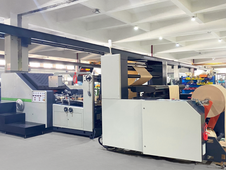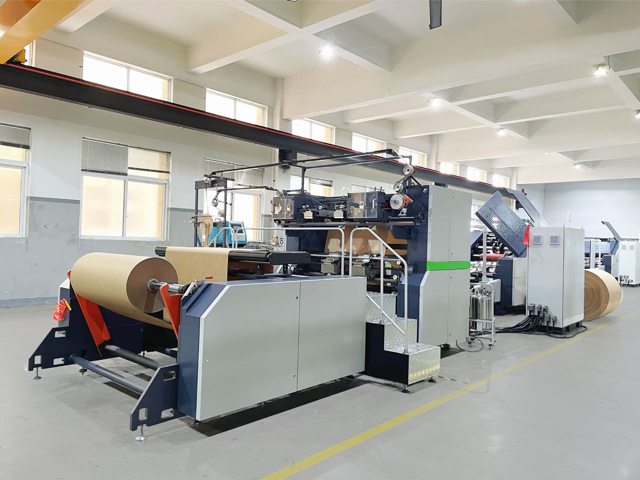In the world of packaging, paper bags have become essential. As demand for sustainable products increases, companies are turning to paper bag handle machines to improve production efficiency. These machines automate the process of adding handles to bags, ensuring quick, consistent results.
In this post, you’ll learn how to operate a high-quality paper bag handle machine. We will walk you through the preparation, materials, machine settings, and best practices for smooth operation. You'll also discover how a reliable machine boosts productivity and product quality, helping you meet eco-friendly goals.
Understanding the High-Quality Paper Bag Handle Machine
A high-quality paper bag handle machine is a specialized piece of equipment that automates the attachment of handles to paper bags. These machines are commonly used in industries that require high-volume production, such as retail, food packaging, and promotional products. By utilizing these machines, manufacturers can enhance production efficiency, improve bag strength, and ensure that the handles are securely attached.
The machine works by feeding paper bags through various stages, where the handles are attached either through gluing, stitching, or heat sealing. Depending on the type of machine, it can handle a variety of bag sizes and handle types, including twisted, flat, and ribbon handles. The result is a consistent, high-quality product ready for distribution.
Step-by-Step Guide to Operating a High-Quality Paper Bag Handle Machine
Step 1: Preparing the Machine
Before starting the production process, it’s essential to properly prepare the machine. This includes conducting an inspection to ensure all components are functioning correctly. Check the rollers, belts, and moving parts for any signs of wear or damage. Any issues should be addressed before the machine is put into operation.
Once the machine is in good condition, load the necessary materials. This includes paper rolls, adhesive or glue, and the handles that will be attached to the bags. Ensure that you are using high-quality materials that are compatible with the machine to avoid any production issues.
Step 2: Loading the Materials
Loading the materials onto the machine is an important step in ensuring smooth operation. Carefully arrange the materials and ensure that each component is in the correct position. For the paper rolls, make sure they are properly aligned and tensioned to prevent misalignment or jamming during production.
Next, load the handles into the machine. The type of handle will depend on the specific requirements of the product being produced. Whether you are using twisted paper, cotton, or recycled polyester handles, ensure that the material is compatible with the machine’s feeding system.
Step 3: Setting Machine Parameters
Once the materials are loaded, the next step is to set the machine parameters. These parameters include speed, tension, temperature, and adhesive application settings. The speed should be adjusted according to the production needs, ensuring that the machine operates efficiently without compromising the quality of the bag handles.
For the handles, the tension should be carefully controlled to ensure that they are securely attached without causing any damage to the paper. Additionally, ensure that the temperature settings are optimized for the type of adhesive being used, as too much heat can weaken the bond between the handle and the bag.

Step 4: Starting the Machine
After all the settings are configured, it’s time to start the machine. Press the start button to begin the production process. The machine will feed the paper bags through the different stages, attaching handles as specified in the settings.
During this process, it’s crucial to monitor the machine closely to ensure everything is functioning as expected. Pay attention to the speed, the alignment of the bags, and the handling of the paper rolls. If any issues arise, such as misalignment or jams, stop the machine immediately to address the problem before continuing production.
Step 5: Troubleshooting and Maintenance
Even the best high-quality paper bag handle machines may experience issues from time to time. Common problems include paper jams, misfeeds, or adhesive problems. Troubleshooting these issues quickly is essential to minimizing downtime and maintaining production flow.
For instance, if a paper jam occurs, the machine should be stopped immediately. Carefully clear the jam, check for any issues with the feeding mechanism, and reload the paper rolls. Regular maintenance, such as lubricating the moving parts, cleaning the rollers, and replacing worn-out components, will help extend the machine’s lifespan and ensure optimal performance.
Step 6: Quality Control and Inspection
Quality control is vital to ensuring that the paper bags meet the desired standards. Regular inspections should be conducted throughout the production process to check for any defects, such as improperly attached handles or weak bonds. The bags should also be inspected for any issues with the paper, such as wrinkles or tears.
Any defective bags should be removed from the production line to prevent them from reaching customers. Implementing a robust quality control system can help catch potential problems early and ensure that only the best products are shipped.
Step 7: Finishing and Packaging
Once the paper bags are produced with their handles securely attached, they must go through the finishing and packaging stages. This includes folding, stacking, and packaging the bags in a way that minimizes damage during transportation. Properly packed bags will ensure that they arrive at their destination in perfect condition.
Packaging should be done according to the customer’s specifications, whether in bulk or in pre-packaged units. Additionally, decorative elements or labels can be added to the bags at this stage to enhance their aesthetic appeal.

Advantages of Using a High-Quality Paper Bag Handle Machine
Investing in a high-quality paper bag handle machine offers numerous benefits for manufacturers, including:
Increased Efficiency: Automated systems can handle hundreds of bags per hour, greatly increasing production speed compared to manual labor.
Consistent Quality: Machines ensure uniform handle placement, reducing the risk of human error and ensuring that every bag meets the same high standards.
Cost Savings: By reducing labor costs and minimizing material waste, these machines can provide significant cost savings over time.
Environmental Impact: Many machines are designed to work with eco-friendly materials, such as biodegradable paper and recyclable handles, helping companies meet sustainability goals.
Choosing the Right Paper Bag Handle Machine
When selecting a paper bag handle machine, consider the following factors to ensure you choose the best option for your needs:
Production Capacity: Consider whether a semi-automatic, automatic, or rotary machine is best suited to your production volume. High-volume operations may benefit from automatic or rotary machines, while small businesses may find semi-automatic machines sufficient.
Handle Compatibility: Ensure that the machine can handle the type of handles you plan to use, whether they are paper, cotton, or other materials.
Ease of Maintenance: Look for machines that are easy to maintain and repair, with accessible parts and a user-friendly interface.
Energy Efficiency: Machines with energy-saving features can help reduce operational costs, making them a more economical choice in the long run.
Conclusion
Operating a high-quality paper bag handle machine may seem complicated at first, but by following the correct steps and understanding the machine’s components and functions, you can ensure a smooth and efficient production process. From preparing the machine and loading materials to troubleshooting and conducting quality control, each step is crucial in producing high-quality paper bags that meet customer expectations.
Selecting the right machine is crucial. For businesses aiming to scale, ROKIN offers top-notch machines designed for efficiency, precision, and sustainability. Investing in a high-quality paper bag handle machine from ROKIN ensures that your production lines stay ahead of demand while adhering to environmental standards.
FAQ
Q: What is a paper bag handle machine?
A: A paper bag handle machine automatically attaches handles to paper bags. It is used in high-volume production for packaging.
Q: How does the machine increase production efficiency?
A: The machine automates handle attachment, reducing manual labor, speeding up the process, and ensuring consistent product quality.
Q: Can the machine be used with different handle types?
A: Yes, it can handle various types of handles, such as twisted, flat, and ribbon handles, depending on your needs.
Q: What maintenance is required for the machine?
A: Regular cleaning, lubrication of moving parts, and periodic inspections are necessary to ensure smooth operation and longevity.



